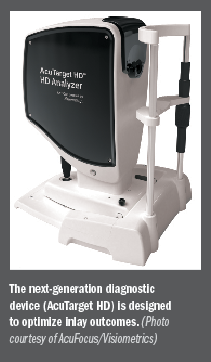Article
Diagnostic, surgical planning device optimizes corneal inlay outcomes
A new guidance device is one of the first instruments of its kind to provide surgeons with objective data pre- and postoperatively for placement of a small-aperture corneal inlay (Kamra, AcuFocus).
Take Home
A new guidance device is one of the first instruments of its kind to provide surgeons with objective data pre- and postoperatively for placement of a small-aperture corneal inlay (Kamra, AcuFocus).
By Nancy Groves; Reviewed by George Waring IV, MD, FACS
Charleston, SC-A new paradigm in ocular diagnostics and surgical guidance (AcuTarget HD, Visiometrics) is designed for the small-aperture corneal inlay (Kamra, AcuFocus), according to George Waring IV, MD, FACS.
“Although the inlay is relatively forgiving in terms of centration, this guidance device aids surgeons in terms of preoperative planning for the inlay placement, as well as the postoperative assessment of inlay placement,” said Dr. Waring, assistant professor of ophthalmology and the director of refractive surgery at the Medical University of South Carolina, Storm Eye Institute, Charleston.

The instrument was designed to improve clinical outcomes by providing guidance for patient selection, surgical planning, and postoperative care. This may be the only commercially available device developed to guide centration, Dr. Waring said. In addition, the device goes well beyond that in terms of providing an “all in one” diagnostic solution for the presbyopia correction procedure, he added.
“It’s a comprehensive diagnostic device for the surgical treatment of presbyopia and particularly well suited to the small-aperture Kamra corneal inlay,” Dr. Waring said.
About the diagnostic device
The device gives surgeons preoperative guidance with data, such as the 1st Purkinje reflex relative to the pupil and both the X and Y coordinates. It also provides the 1st Purkinje location relative to the pupil in terms of the cord length and pupil angle, and it identifies where the intended placement of the Kamra inlay should be.
Dr. Waring recommended using the printouts from the device’s analyzer during surgery for reference in placement of the inlay relative to the reproducible landmarks. Postoperatively, he recommended using it to assess where the inlay is relative to the 1st Purkinje image and the pupil, confirm the inlay location with the X and Y coordinates, and confirm that the desired placement was achieved.
The AcuTarget HD also evaluates the quality of vision, both preoperatively and postoperatively using the objective scatter index (OSI). This enables the surgeon to assign a numerical value to the overall optical quality of vision by measuring the true amount of light scatter on the retina. With this feature, the surgeon can preoperatively evaluate the visual quality, which can aid in patient selection. The OSI and point spread function are objective measurements that describe quality, which cannot be adequately detected with a slit lamp exam.
Other metrics include predicted visual acuity and modular transfer function, the difference in contrast between the object, and the image on the retina.
“This helps you confirm whether a patient is a good candidate for surgery,” Dr. Waring said. “If they come in and they’ve got poor image quality preoperatively, first you need to figure out why, then you may have an opportunity to optimize their vision before you place the corneal inlay.”
Further benefits
A healthy ocular surface is critical for any surgical patient, and the device’s tear film assessment program is another beneficial feature both preoperatively and postoperatively. This program measures the effect of tear film on optical quality, and repeated measurements over time may help the surgeon assess the effectiveness of ocular surface optimization. This information, too, can help determine whether a patient is a good candidate for the inlay, Dr. Waring said.
The device is particularly useful in its ability to measure depth of focus preoperatively and after inlay implantation, he said. It is one of few devices with the ability to objectively assess this both preoperatively and postoperatively.
“These patients are coming in to get out of reading glasses because they’ve lost their ability to accommodate with age-related changes from presbyopia,” Dr. Waring explained. “You can measure the patient’s depth of focus and plot a depth of focus curve that shows the related point spread function over a focus range or with changes of dioptric power.”
Preoperatively, he said this would show that the patient is only in focus in an extremely small range due to the lack of accommodation, while postoperatively, the same assessment will show that the eye is in focus across a broad range of focal points.
“It’s really powerful to be able to show the patient pre-op and post-op how you’ve restored their reading vision,” Dr. Waring said. “The (device) not only provides surgical guidance, it is an example of the next generation of diagnostics which provide objective measurements of functional vision.”
George Waring IV, MD, FACS
Dr. Waring is a consultant to Visiometrics and AcuFocus.
Newsletter
Don’t miss out—get Ophthalmology Times updates on the latest clinical advancements and expert interviews, straight to your inbox.




